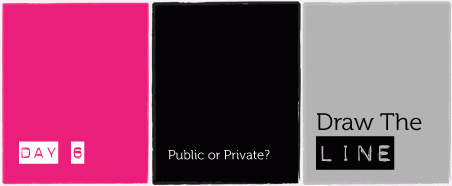
When you are in a cybercafe, having an online chat with your boyfriend, is it public or private? When you put something up on Facebook, to be seen only by people who are in your network, is it private or public? When you shoot a picture of yourself with your mobile phone, and MMS it to a friend, does it become public because you lose control over how the image might continue to be circulated? When you send an email using a free webmail service who stores all the data, is it still private or has it become privatised by a publicly-listed corporation? When your parents or partner insist on reading all your SMS messages, are they no longer private? When an-ex sends you threatening and harassing emails to your personal account, is it still a private affair between 2 persons?
Digital technologies have blurred some of the lines that we think of as dividing what is private, and what is public. It's no longer just about physical spaces, like how it was commonly understood before, where the home is in the private domain and the public is everything outside. This didn't always work to women's advantage either, when offenders of domestic violence tried to argue that it was not the business of courts to intervene in what he does at home to his own wife.
But with online platforms and its networked nature, sometimes what we assume to be private can actually be quite public, as explored on the action in Day 2. This is especially complex when it comes to relationships you have with people close to you, such as your friends, partner or family members. When you send an email thinking that it is private, the other person might think it's okay to forward it to a group of mutual friends. Parents and partners might feel completely entitled to check on your phone, or do random web searches on you just to see what you've been up to online. When you take a picture with someone and both of you have a digital copy, they might think that it belongs to her/him as much as it belongs to you, and what happens when you think its private but s/he thinks its okay to post it everywhere?
You decide what is public or private. Draw the line. Make it known.
Private | Public Cards
- Define your communication spaces and tools as private or public by marking it with a card.
- Download and print out the Private | Public cards (or make your own!)
- The black label of the card is for what you define as "Private"
- The pink lable of the card is for what you define as "Public"
- Think about a communication platform or space, and decide on the context and situation when they can be public and when are they private.
- Under the section labelled as "Private" or "Public", write down your definition.
- For example, under "Public", write down: "Journal - Only if I tell you it's okay to read it", or
- For example, under "Private", write down: "Room - If the door is shut"
- Or if it is always "Public" or "Private", just write down: "Room & Journal - Always" :)
- Stick it up on the space you named. On your computer, room door, mobile phone, car dashboard, kitchen table, anywhere where communication happens.
- Or hand it to someone to have a conversation with. It's also about communicating clearly what the lines to people around you.
2. "Private | Public" Online Banner
- Start a conversation on your online spaces whether something should be private or public.
- Download "Public | Public" banner.

- Or copy and paste this code in the html section of your post.
 " width="145" height="83" border="0" alt="Private | Public? Draw the line! Take Back The Tech" />
" width="145" height="83" border="0" alt="Private | Public? Draw the line! Take Back The Tech" /> - Add it to your blog post, social networking site status message, as your online messenger icon.
- Talk about it. Define it. And draw the line!
| Attachment | Tamaño |
|---|---|
| public_private.pdf | 223.07 KB |
- Log in to post comments

